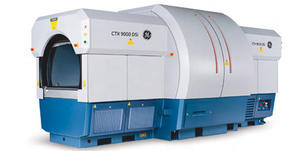Air-cargo screeningNew baggage screening system from Morpho Detection evaluated
Unlike most baggage-screening systems that create two-dimensional images of objects inside luggage, the CTX 9800 DSi scanners from Morpho Detection create three-dimensional images that can be digitally manipulated by personnel when a bag is deemed to be suspicious; the machines also use advanced software to detect suspicious items; Mineta San Jose International Airport once used 28 machines to process 1,800 bags an hour, but the new system will be able to process the same number of bags using eight machines and require fewer employees to supervise the process; the technology reduces reliance on human observation and interaction with the bags; for the majority of bags, employee contact is only required when a piece of luggage is placed on or taken off the conveyor belt

The CTX 9xxx series builds three-dimensional images of baggage contents // Source: morpho.com
Later this month the Transportation Security Administration (TSA) will begin a formal testing period for a new baggage screening system at Mineta San Jose International Airport. The state-of-the-art baggage-screening system, made by Morpho Detection, could be rolled out to airports across the United States if the machines perform well.
The system is part of a federal initiative to replace older baggage-screening machines in U.S. airports with more efficient and accurate models. After a formal 45-day evaluation period, the agency will determine whether to purchase additional Morpho systems and at which airports they will be deployed, says TSA spokesman Nicholas Kimball.
Marie C. Baca writes in the Wall Street Journal that since the $45 million system began a trial run in June, some problems have cropped up. Airport spokesman David Vossbrink says software issues led to dozens of lost bags and some delayed flights one weekend in June. In addition, baggage mishandling incidents — for example, when airport employees place a child car seat on a conveyer belt sideways instead of lengthwise — have slowed the system on several occasions, he says.
Overall, Vossbrink acknowledged there have been glitches in service. Neil Bloomfield, Morpho’s general manager of Americas aviation, adds there have been “teething problems” with the new system. Both say software patches and additional employee training appear to have fixed the problems and that all parties are working together to make sure the system functions smoothly.
Baca quotes Douglas Laird, a Reno, Nevada, airport security consultant, to say that such problems are not abnormal when implementing a new generation of machines. “It’s one thing for a device to work in a TSA laboratory, but it’s quite another for it to work in the real world,” he said.
Minor technical issues, however, can sometimes lead to bigger problems, Charles Slepian, an aviation-security consultant in Lake Oswego, Oregon, told Baca. “If people are asked to search too many bags by hand because of a little glitch, eventually they are going to get fatigued and stop searching them thoroughly,” possibly letting through items that are actually dangerous, he said.
Slepian said the logistics of deploying a baggage-screening system are more complicated than installing the controversial full-body scanners that have begun to appear in U.S. airports. The new baggage-screening machines “cost about double if not triple the price of body scanners,” he said. “You’re also talking about shutting down baggage flow during the installation process, so the whole thing
